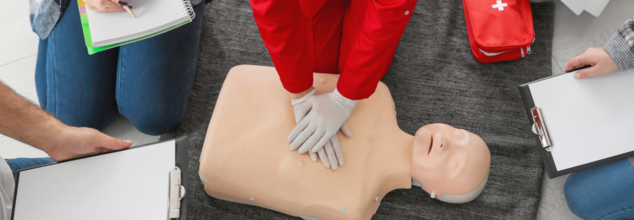- Health Conditions A-Z
- Health & Wellness
- Nutrition
- Fitness
- Health News
- Ayurveda
- Videos
- Medicine A-Z
- Parenting
Know What to Do: CPR and AED Basics for Everyone

Credits: Canva
Last year in June, when a woman collapsed on an escalator at Buffalo's airport, and Phil Clough, who is an experienced emergency medical responder knew exactly what to do. He and a bystander, as the Washington Post reported, quickly laid the woman flat on her back. They checked her pulse and breath. Her pulse was faint and her breathing was shallow and erratic. A few moments later, she stopped breathing altogether.
Realizing she might be experiencing a cardiac arrest, Clough immediately began performing chest compressions. He pressed hard and fast on the center of her chest while other bystanders called 911 and fetched an automated external defibrillator (AED). Within seconds of receiving a shock from the AED, the woman opened her eyes. By the time the airport rescue team arrived, just minutes later, she was conscious and able to speak.
Clough’s quick actions saved the woman’s life, but he credits his preparedness to a life-changing incident several years earlier. After witnessing a woman collapse at his gym and feeling helpless, he took a college course to become certified as an emergency medical responder. This training allowed him to respond with confidence when faced with a life-or-death situation.
The Challenge of Cardiac Arrest
The woman in Buffalo was fortunate that bystanders knew how to respond. Unfortunately, most people who experience cardiac arrest do not receive immediate help.
According to the American Heart Association, more than 350,000 cardiac arrests occur outside of hospitals in the U.S. annually. Tragically, 90% of these individuals do not survive, often because help arrives too late. For each minute that passes without intervention, a person’s chances of survival decrease by 10%. However, with prompt cardiopulmonary resuscitation (CPR) and an AED shock if necessary, survival rates can double or even triple.
Despite the importance of swift intervention, fewer than half of people who suffer cardiac arrest outside of a hospital setting receive immediate assistance. This lack of action is often due to a lack of training and preparedness. Cardiac arrest can happen anywhere, but with public access to AEDs and trained bystanders, survival rates could improve dramatically.
The Role of AEDs in Saving Lives
A crucial part of treating cardiac arrest is the use of an AED, a portable device that delivers an electric shock to the heart. The AED analyzes the heart’s rhythm and guides the user through the steps to apply a shock if needed. Although many states require AEDs to be available in public places such as airports and malls, they are not always easy to find. A study spanning 2019 to 2022 revealed that in public settings, AEDs were used only 7% of the time, and CPR was performed 42% of the time after a cardiac arrest incident.
To address this issue, PulsePoint, a nonprofit organization, has registered 185,000 AEDs in 5,400 U.S. communities, reports the Washington Post. The group’s goal is to help communities build their AED registries and integrate them with local 911 services. In addition, PulsePoint’s mobile app alerts trained CPR responders about nearby cardiac arrests and identifies the closest AEDs, enhancing the chances of saving a life.
Overcoming Barriers to Bystander Intervention
While CPR and AED knowledge can save lives, many people hesitate to intervene during an emergency due to fear of making a mistake, lacking confidence, or worrying about legal liability. However, all 50 states and Washington, D.C. have “Good Samaritan” laws that protect individuals from legal consequences when they provide help in a medical emergency.
Lack of CPR training is another significant barrier. A study found that only 18% of people had received CPR training within the last two years, which is crucial for skill retention. Although many people have received CPR training at some point in their lives, the skills may be outdated or forgotten.
To address this, some states have made CPR training mandatory for high school graduation, and countries like Denmark and Norway have implemented similar requirements. In the U.S., CPR courses are widely available online and in-person, and many take just a few hours to complete. These courses teach individuals the basics of CPR, which involves performing chest compressions at a rate of 100 to 120 per minute and a depth of at least two inches.
Is Santa Claus Bad for Your Health? Here’s Why a Doctor Is Raising Concerns Ahead of Christmas

Credits: iStock
Santa Claus is bad for your health! This is a statement by Dr Nathan Grills, a Public Health Fellow in the Department of Epidemiology and Preventative Medicine, Monash University, Australia. Why is he saying this right ahead of Christmas?
Writing for an article in the British Medical Journal's Christmas issue (BMJ), he says, "Santa only needs to affect health by 0.1% to damage million of lives". He says it would be better if his popularity was rather used to promote healthy living.
Why Is Santa Claus Unhealthy?
Santa Claus's portrayal is where the concerns lie. This was not the first time someone has talked about. In fact, The Conversation in December 2024, talked about this exactly. If you look at Santa, he stands anywhere between 5'6" to 6'6" and weighs between 80Kgs to 136Kgs. He also carries a lot of weight around his belly, which, some may say, keeps him insulated as he sleighs through the snowy lands, but is sure overweight and obese. These portrayal promotes an unhealthy living.
Dr Grils also writes that Santa should rather share Rudolf's snack of carrots and celery sticks than brandy and mince pies, and swap his reindeer for a bike or a walk.
After reviewing existing literature and online sources to understand Santa Claus’s possible impact on public health, the analysis found no peer-reviewed studies directly addressing the issue. What did stand out, however, was the exceptionally high level of awareness of Santa among children. In fact, surveys of American schoolchildren showed that Santa Claus was recognized more widely than almost any other fictional character, second only to Ronald McDonald.
The doctor says that Santa is also used for selling products, which are mostly harmful, and this happens on global scale, which means, people get inspired. "Santa sells, and sometimes he sells harmful products. Like Coca-Cola, Santa has become a major export item to the developing world."
While Santa has been banned from smoking, but his images of enjoying a pipe or cigar are easily found on Christmas cards. The depiction of Santa does form a public perception, argues the doctor.
Dr Grill also notes that Santa may be promoting potential drink-driving, especially when someone follows the tradition to leave him a brandy to wish him well on his travels, while he has billion houses to visit.
Can Santa Spread Diseases?

Dr Grill says that he can spread diseases. If Santa sneezes or coughs around 10 times a day, all the children who sit on his lap may also end up catching the flu along with their Christmas presents.

However, it is important to note that these are views expressed by the doctor and no actual studies have been conducted on the same, Though Dr Grill does indicate for more research before calling for authorities to regulate Santa's activities. For now, Dr Grill proposes a new image for Santa, a healthier one. A slim Santa on a treadmill.
Did You Know The Role Appendix Plays In Your Body? It Is More Important Than You Think

Credits: iStock
For years, the appendix was brushed off as a useless leftover from human evolution. Many of us grew up believing that it served no real purpose and was better off removed at the first sign of trouble. But science now tells a more interesting story. This small, finger-like pouch attached to the large intestine quietly supports gut health and immunity in ways that were long overlooked.
What exactly is the appendix?
The appendix is a narrow tube connected to the cecum, located in the lower right side of the abdomen. It usually measures between 7 and 10 cm, although its size and position can vary widely from person to person. In some people, it may be just a couple of centimeters long, while in others, it can extend much further. This variation is also why appendicitis pain can sometimes feel confusing or atypical.
Not useless after all
The biggest shift in understanding the appendix came from research into gut bacteria. The appendix appears to act as a safe storage space for beneficial microbes. During bouts of severe diarrhea or intestinal infections, large amounts of gut bacteria are flushed out. The appendix helps reintroduce these good bacteria once the illness passes, helping the digestive system recover faster.
It also plays a role in immunity, especially during early life. The appendix contains lymphoid tissue, which exposes immune cells to substances passing through the gut. This helps the body learn how to respond to harmful invaders while tolerating harmless ones. While humans can survive perfectly well without an appendix, its presence offers subtle support to the immune and digestive systems.
Why appendicitis happens
Despite its benefits, the appendix is still prone to inflammation. Appendicitis is one of the most common abdominal emergencies worldwide. It usually occurs when the appendix gets blocked, often due to hardened stool, infection, or rarely, abnormal growths. Once blocked, bacteria multiply, causing swelling, pain, and infection.
The classic warning sign is pain that starts near the belly button and gradually shifts to the lower right abdomen. This may be accompanied by fever, nausea, vomiting, and loss of appetite. Ignoring these symptoms can be dangerous. If left untreated, the appendix can rupture, leading to serious and potentially life-threatening complications.
Busting Common Myths
There are many myths surrounding the appendix. One of the most common is that fruit seeds or spicy food cause appendicitis. There is no evidence to support this. Another misconception is that appendicitis can settle on its own. While pain may temporarily reduce, the underlying inflammation usually worsens.
Many people also worry that removing the appendix will harm digestion or require lifelong dietary restrictions. In reality, most people return to normal eating habits and daily routines after recovery, with no long-term health issues.
How appendicitis is treated
Surgery remains the most reliable treatment for appendicitis. Today, minimally invasive techniques such as laparoscopic or robotic surgery are widely used. These involve small incisions, less pain, quicker recovery, and shorter hospital stays. In complicated cases, open surgery may still be required.
In selected cases of mild, uncomplicated appendicitis, antibiotics may be used initially. However, studies show that while symptoms may improve, there is a higher chance of recurrence within months. For this reason, surgery continues to be the definitive, long-term solution for most patients.
Recovery after appendix removal is usually smooth. Many patients are able to walk the same day and return home within a day or two. Light meals are recommended initially, and heavy lifting is avoided for a few weeks. Long-term lifestyle changes are rarely needed, and most people forget about the surgery entirely once healed.
Delhi AQI Stays ‘Very Poor’ As CM Rekha Gupta Holds Review Meet For Pollution

Credits: iStock
Delhi's air quality remained in "very poor" category, and the AQI stood at 342 at 8am, as per the Central Pollution Control Board. The 24-hour average AQI was logged at 412 under the "severe" category on Tuesday evening when Delhi's quality peaked to record the fourth severe air day in the month of December. With the air quality levels remaining continuously in the "very poor" category, Delhi's Chief Minister Rekha Gupta held a pollution review meet.
What Was Discussed In The Pollution Review Meet By Rekha Gupta?
A review meeting was held to discuss the rising air pollution levels in Delhi on Monday at the Delhi Secretariat. The meeting was attended by the officials from various departments, which also included the Public Works Department (PWD), Transport, Delhi Pollution Control Committee (DPCC), Environment, and others.
Post meeting, Delhi Environment Minister Manjinder Singh Sirsa said that the CM sought responses from multiple departments to discuss various aspects of pollution in the national capital. Sirsa also confirmed that a follow-up meeting will be scheduled on Thursday to continue the discussions on various steps that should be taken to bring down the levels of Delhi's AQI.
Rely On Public Transport - As A Solution To Delhi Pollution
On Sunday, a day before the meeting was held, Delhi's CM spoke on relying on public transport as a solution to Delhi's pollution. She said that the government aims to make the metro network "so comprehensive that people do not need to rely on private vehicles even for last-mile connectivity”.
Delhi's Pollution Is Now A Public Health Risk
An analysis by the Global Burden of Disease (GBD) 2023 found that air pollution is city's single largest health risk. The deaths rose from 15,786 in 2018 to 17,188 in 2023.
Another study published in Scientific Reports, a five-year study titled Respiratory Deposition of Particulate Matter in Delhi: A Five-Year Assessment of Exposure Patterns and Health Risks tracked how particulate matter settles inside the respiratory system and found that men's exposure can be up to 1.4 times higher, especially while walking or commuting. The study noted that men on average spend more time outdoors while working, commuting, or walking in traffic-heavy areas. This leads to an increase in exposure.
A different study published in Frontiers in Public Health, explored the data of 2,96,078 women and girls between the age of 16 to 55 years in Taiwan and correlated it with the long-term air pollution data between 2000 and 2013. None of these women had any history of dysmenorrhea before the survey had began.
Read: Is Delhi's Toxic Air Making Your Period Cramps More Painful? Here's What Study Says
Furthermore, a study published in Nature Communication notes that after four hours of exposure to particulate matter, it was found that people's ability to perform routine tasks and interpret emotions were highly impacted.
If Delhi is able to cut its local pollution by 50 per cent, the pollution too could drop by 50 per cent. The emission should happen across the airshed. However, the focus should be for a long-term action on the source of emission and not short-term optics like cloud seeding, smog towers, water sprinkling or air purifiers.
In fact, as per a study published in Sustainability (MDPI), an open access journal, which mapped Delhi's air quality between 1990 to 2022 and found that transports emit around 10 to 30% of pollution, whereas agricultural residue burning, which is a seasonal source of pollution leads to less than 3% of pollution, whereas firecrackers, another seasonal source, leads to less than 1% of pollution.
© 2024 Bennett, Coleman & Company Limited

